An Efficient Resource Allocation Algorithm for OFDM-Based NOMA in 5G Systems
Abstract
1. Introduction
2. System Model
3. Proposed Algorithm
3.1. User Grouping Scheme
| Algorithm 1 Proposed GA Based User Grouping |
Initialization. Set of subcarriers , set of users , set of superimposed users on each subcarrier , let , the k-th user average data rate is , where subcarrier , user , number of iterations
|
3.2. Power Allocation Scheme
| Algorithm 2 Proposed PAA |
|
4. Complexity Analysis
5. Simulation Results and Performance Analysis
6. Conclusions
Author Contributions
Funding
Acknowledgments
Conflicts of Interest
References
- Islam, S.M.; Zeng, M.; Dobre, O.A.; Kwak, K.S. Non-Orthogonal Multiple Access (NOMA): How It Meets 5G and Beyond. arXiv 2019, arXiv:1907.1000. [Google Scholar]
- Baghani, M.; Parsaeefard, S.; Derakhshani, M.; Saad, W. Dynamic Non-Orthogonal Multiple Access and Orthogonal Multiple Access in 5G Wireless Networks. IEEE Trans. Commun. 2019, 67, 6360–6373. [Google Scholar] [CrossRef]
- Dai, L.; Wang, B.; Ding, Z.; Wang, Z.; Chen, S.; Hanzo, L. A Survey of Non-Orthogonal Multiple Access for 5G. IEEE Commun. Surv. Tutor. 2018, 20, 2294–2323. [Google Scholar] [CrossRef]
- Yang, K.; Yang, N.; Ye, N.; Jia, M.; Gao, Z.; Fan, R. Non-Orthogonal Multiple Access: Achieving Sustainable Future Radio Access. IEEE Commun. Mag. 2019, 57, 116–121. [Google Scholar] [CrossRef]
- Islam, S.R.; Avazov, N.; Dobre, O.A.; Kwak, K.S. Power-Domain Non-Orthogonal Multiple Access (NOMA) in 5G Systems: Potentials and Challenges. IEEE Commun. Surv. Tutor. 2017, 19, 721–742. [Google Scholar] [CrossRef]
- Liu, Y.; Qin, Z.; Elkashlan, M.; Ding, Z.; Nallanathan, A.; Hanzo, L. Nonorthogonal Multiple Access for 5G and Beyond. Proc. IEEE 2017, 105, 2347–2381. [Google Scholar] [CrossRef]
- Zhang, X.; Wang, F. Resource Allocation for Wireless Power Transmission Over Full-Duplex OFDMA/NOMA Mobile Wireless Networks. IEEE J. Sel. Areas Commun. 2019, 37, 327–344. [Google Scholar] [CrossRef]
- Haci, H.; Zhu, H.; Wang, J. Performance of Non-Orthogonal Multiple Access with a Novel Asynchronous Interference Cancellation Technique. IEEE Trans. Commun. 2017, 65, 1319–1335. [Google Scholar] [CrossRef]
- Cai, W.; Chen, C.; Bai, L.; Jin, Y.; Choi, J. Subcarrier and Power Allocation Scheme for Downlink OFDM-NOMA Systems. IET Signal Process. 2017, 11, 51–58. [Google Scholar] [CrossRef]
- Manglayev, T.; Kizilirmak, R.C.; Hamid, N.A.W.A. GPU Accelerated PIC and SIC for OFDM-NOMA. Electronics 2019, 8, 257. [Google Scholar] [CrossRef]
- Tseng, S.M.; Tsai, W.D.; Suo, H.S. Cross-Layer 1 and 5 User Grouping/Power Allocation/Subcarrier Allocations for Downlink OFDMA/NOMA Video Communications. Int. J. Commun. Syst. 2019, 32, 1–12. [Google Scholar] [CrossRef]
- Wang, S.; Cao, S.; Ruby, R. Optimal Power Allocation in NOMA-Based Two-Path Successive AF Relay Systems. EURASIP J. Wirel. Commun. Netw. 2018, 273, 1–12. [Google Scholar] [CrossRef]
- Uddin, M.F. Energy Efficiency Maximization by Joint Transmission Scheduling and Resource Allocation in Downlink NOMA Cellular Network. Comput. Netw. 2019, 159, 37–50. [Google Scholar] [CrossRef]
- Islam, S.R.; Zeng, M.; Dobre, O.A.; Kwak, K.S. Resource Allocation for Downlink NOMA Systems: Key Techniques and Open Issue. IEEE Wirel. Commun. 2018, 25, 40–47. [Google Scholar] [CrossRef]
- Li, Q.C.; Niu, H.; Papathanassiou, A.T.; Wu, G. 5G Network Capacity: Key Elements and Technologies. IEEE Veh. Technol. Mag. 2014, 9, 71–78. [Google Scholar] [CrossRef]
- Benjebbour, A.; Saito, Y.; Kishiyama, Y.; Li, A.; Harada, A.; Nakamura, T. Concept and Practical Considerations of Non-Orthogonal Multiple Access (NOMA) for Future Radio Access. In Proceedings of the International Symposium on Intelligent Signal Processing and Communications Systems, Naha, Japan, 12–15 November 2013; pp. 770–774. [Google Scholar]
- Saito, Y.; Benjebbour, A.; Kishiyama, Y.; Nakamura, T. System-Level Performance Evaluation of Downlink Non-Orthogonal Multiple Access (NOMA). In Proceedings of the IEEE International Symposium on Personal, Indoor and Mobile Radio Communications, London, UK, 8–11 September 2013; pp. 611–615. [Google Scholar]
- Agiwal, M.; Roy, A.; Saxena, N. Next-Generation 5G Wireless Networks: A Comprehensive Survey. IEEE Commun. Surv. Tutor. 2016, 18, 1617–1655. [Google Scholar] [CrossRef]
- Li, A.; Lan, Y.; Chen, X.; Jiang, H. Non-orthogonal Multiple Access (NOMA) for future Downlink Radio Access of 5G. China Commun. 2015, 12, 28–37. [Google Scholar] [CrossRef]
- Benjebbovu, A.; Li, A.; Saito, Y.; Kishiyama, Y.; Harada, A.; Nakamura, T. System-level Performance of Downlink NOMA for Future LTE Enhancements. In Proceedings of the IEEE GLOBECOM Workshops, Atlanta, GA, USA, 9–13 December 2014; pp. 66–70. [Google Scholar]
- Eddo, Z.; Hojeij, M.R.; Nour, C.A.; Farah, J.; Douillard, C. Evaluation of Intra-Subband Power Allocation for a Downlink Non-Orthogonal Multiple Access (NOMA) System. In Proceedings of the IEEE GLOBECOM Workshops, Washington, DC, USA, 4–8 December 2016; pp. 1–7. [Google Scholar]
- Otao, N.; Kishiyama, Y.; Higuchi, K. Performance of Non-Orthogonal Access with SIC in Cellular Downlink Using Proportional Fair-Based Resource Allocation. In Proceedings of the International Symposium on Wireless Communications Systems, Paris, France, 28–31 August 2012; pp. 476–480. [Google Scholar]
- Lei, L.; Yuan, D.; Ho, C.K.; Sun, S. Power and Channel Allocation for Non-Orthogonal Multiple Access in 5G Systems: Tractability and Computation. IEEE Trans. Wirel. Commun. 2016, 15, 8580–8594. [Google Scholar] [CrossRef]
- Parida, P.; Das, S.S. Power Allocation in OFDM Based NOMA Systems: A DC Programming Approach. In Proceedings of the IEEE GLOBECOM Workshops, Austin, TX, USA, 8–12 December 2014; pp. 1026–1031. [Google Scholar]
- Hojeij, M.R.; Farah, J.; Nour, C.A.; Douillard, C. Resource Allocation in Downlink Non-Orthogonal Multiple Access (NOMA) for Future Radio Access. In Proceedings of the IEEE 81st Vehicular Technology Conference (VTC), Glasgow, UK, 11–14 May 2015; pp. 1–6. [Google Scholar]
- De Souza, J.H.I.; Abrão, T. Hybrid Hughes-Hartogs Power Allocation Algorithms for OFDMA Systems. IET Signal Process. 2018, 12, 1185–1192. [Google Scholar] [CrossRef]
- Al-Abbasi, Z.Q.; So, D.K. Power Allocation for Sum Rate Maximization in Non-Orthogonal Multiple Access System. In Proceedings of the IEEE International Symposium on Personal, Indoor, and Mobile Radio Communications (PIMRC), Hong Kong, China, 30 August–2 September 2015; pp. 1649–1653. [Google Scholar]
- Ye, N.; Wang, A.; Li, X.; Liu, W.; Hou, X.; Yu, H. On Constellation Rotation of NOMA with SIC Receiver. IEEE Commun. Lett. 2018, 22, 514–517. [Google Scholar] [CrossRef]
- Mahady, I.A.; Bedeer, E.; Ikki, S.; Yanikomeroglu, H. Sum-Rate Maximization of NOMA Systems under Imperfect Successive Interference Cancellation. IEEE Commun. Lett. 2019, 23, 474–477. [Google Scholar] [CrossRef]
- Yu, W.; Rhee, W.; Boyd, S.; Cioffi, J.M. Iterative Water-Filling for Gaussian Vector Multiple-Access Channels. IEEE Trans. Inf. Theory 2004, 50, 145–152. [Google Scholar] [CrossRef]
- Wang, H.; Hou, Y.; Zhang, Y. Joint Power Allocation for OFDM Systems with Cooperation at the Transmitters. EURASIP J. Wirel. Commun. Netw. 2012, 154, 1–9. [Google Scholar] [CrossRef][Green Version]
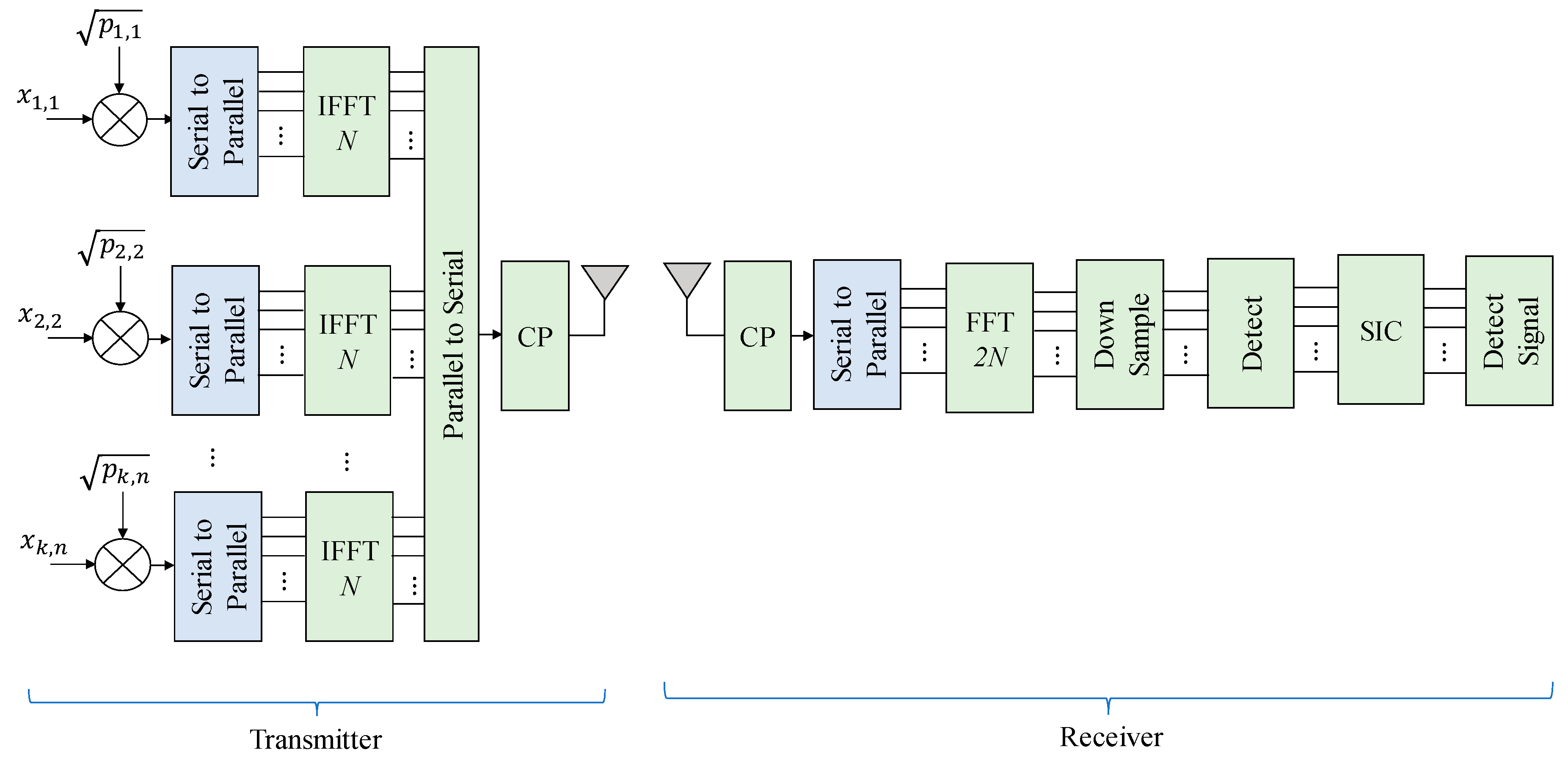
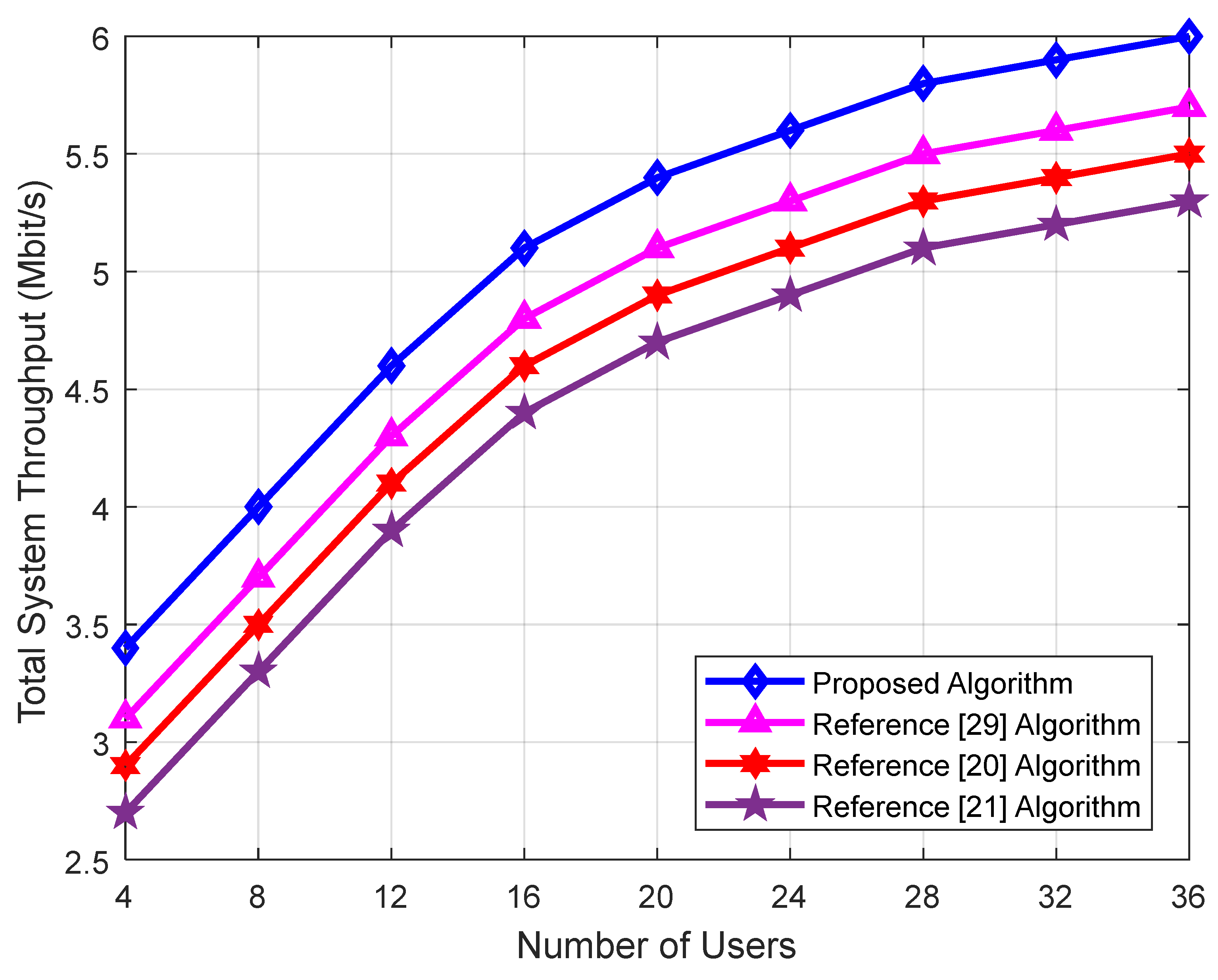
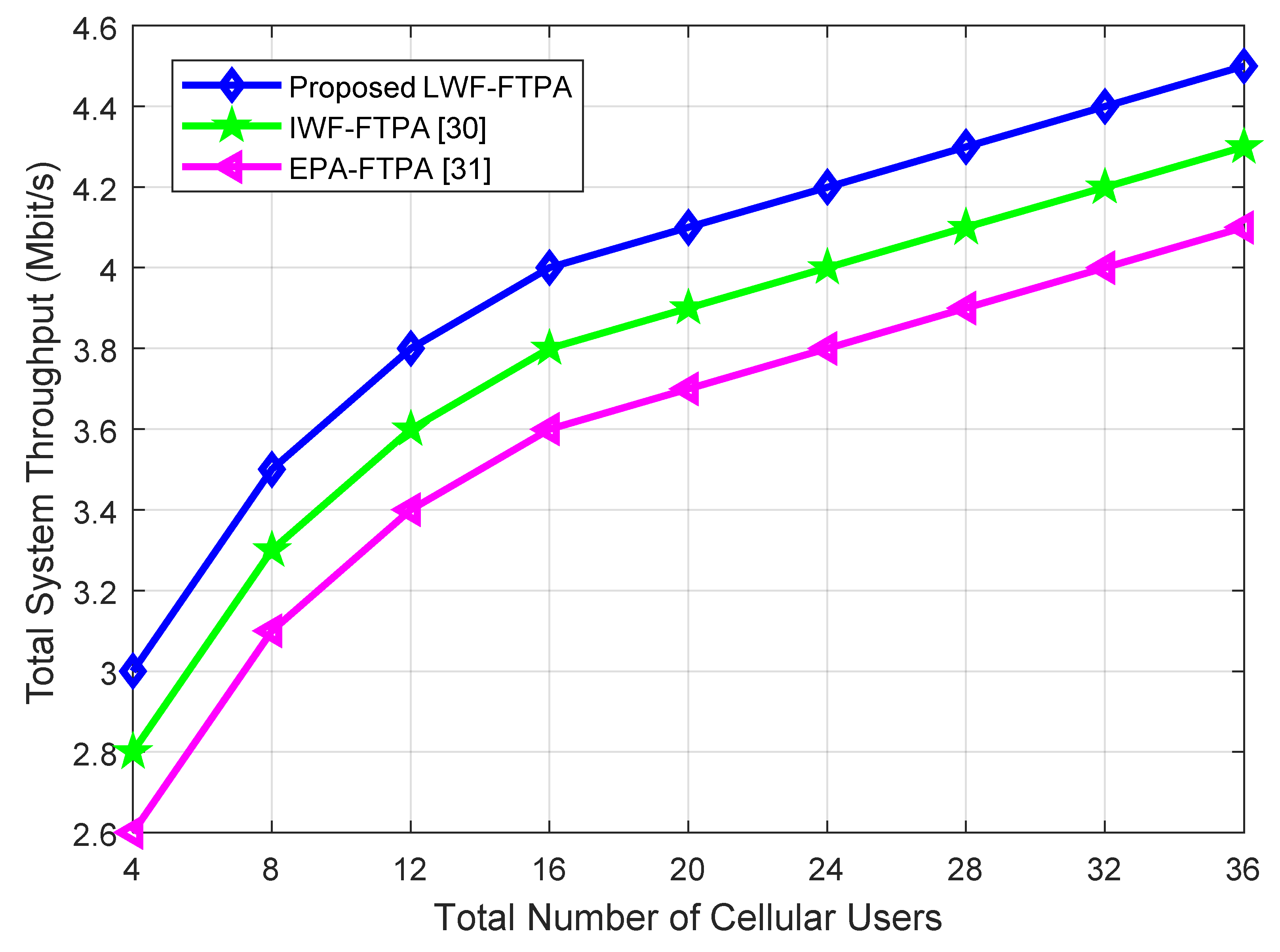
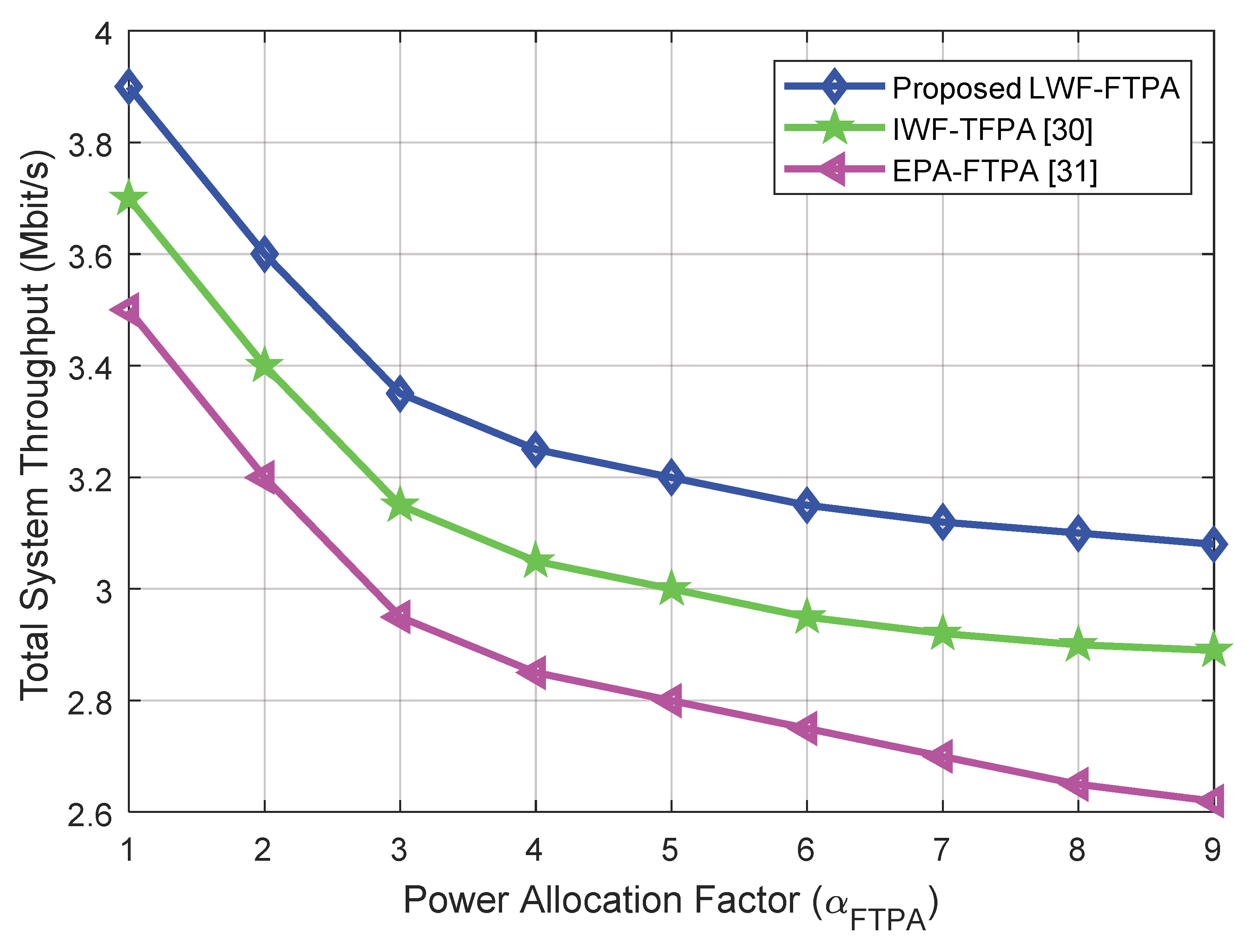
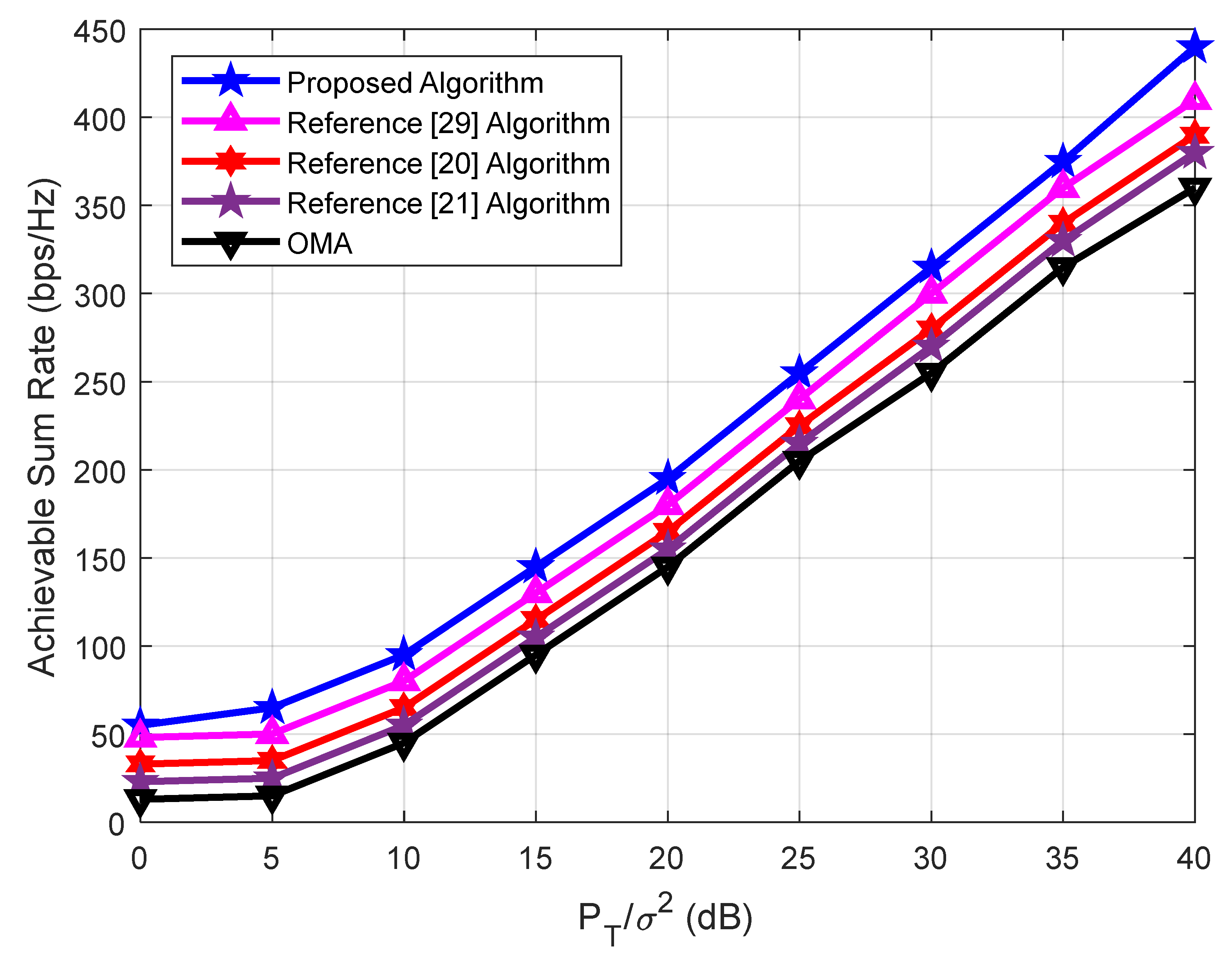
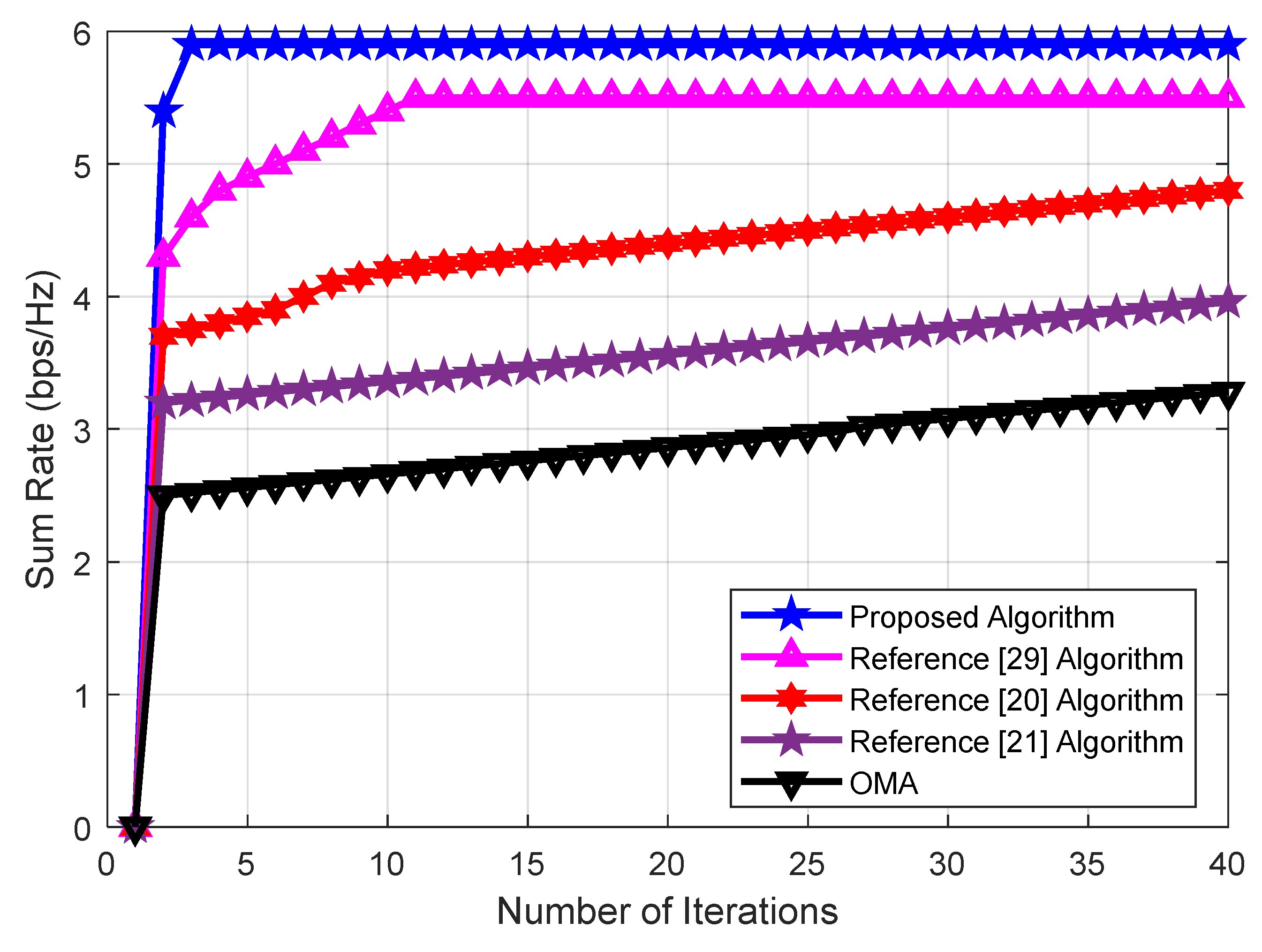
| Parameter | Value |
|---|---|
| System bandwidth | 10 MHz |
| Wavenumber of subcarriers | 64 |
| Delay extension | 5 μs |
| Base station transmit power | 30 dBm |
| Channel model | Rayleigh fading channel |
| Number of overlay users | 2 |
| Maximum Doppler shift | 30 Hz |
| Noise power spectral density | –174 dBm/Hz |
| Channel attenuation factor | 0.2 |
© 2019 by the authors. Licensee MDPI, Basel, Switzerland. This article is an open access article distributed under the terms and conditions of the Creative Commons Attribution (CC BY) license (http://creativecommons.org/licenses/by/4.0/).
Share and Cite
Saraereh, O.A.; Alsaraira, A.; Khan, I.; Uthansakul, P. An Efficient Resource Allocation Algorithm for OFDM-Based NOMA in 5G Systems. Electronics 2019, 8, 1399. https://doi.org/10.3390/electronics8121399
Saraereh OA, Alsaraira A, Khan I, Uthansakul P. An Efficient Resource Allocation Algorithm for OFDM-Based NOMA in 5G Systems. Electronics. 2019; 8(12):1399. https://doi.org/10.3390/electronics8121399
Chicago/Turabian StyleSaraereh, Omar A., Amer Alsaraira, Imran Khan, and Peerapong Uthansakul. 2019. "An Efficient Resource Allocation Algorithm for OFDM-Based NOMA in 5G Systems" Electronics 8, no. 12: 1399. https://doi.org/10.3390/electronics8121399
APA StyleSaraereh, O. A., Alsaraira, A., Khan, I., & Uthansakul, P. (2019). An Efficient Resource Allocation Algorithm for OFDM-Based NOMA in 5G Systems. Electronics, 8(12), 1399. https://doi.org/10.3390/electronics8121399






